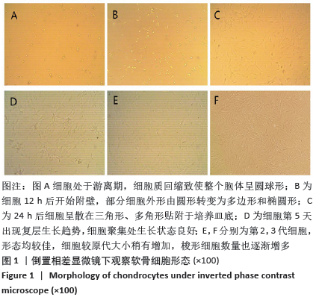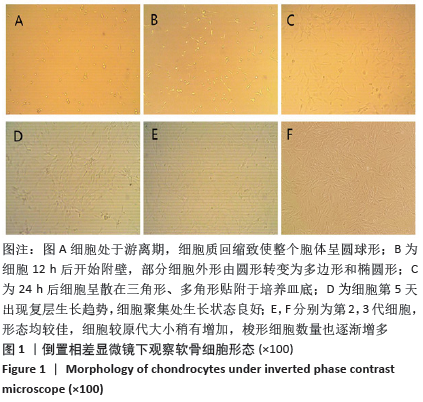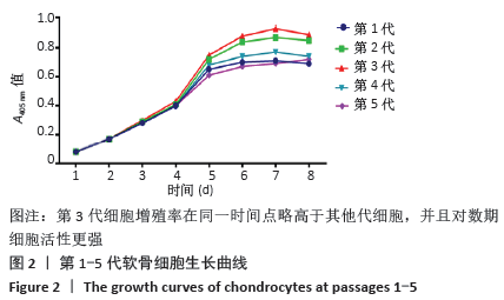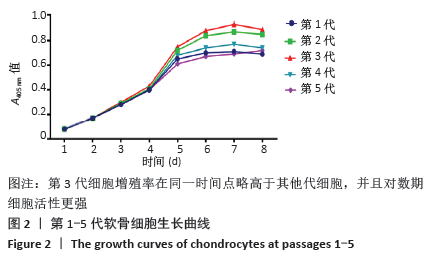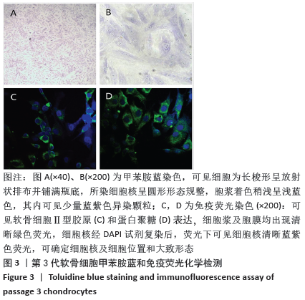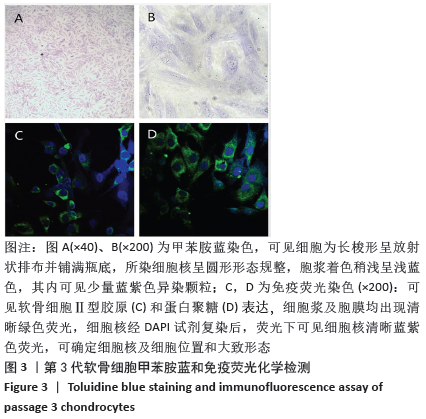[1] 魏钰,魏民.人骨关节炎软骨细胞的体外分离与培养[J].中国组织工程研究,2019,23(25):4056-4061.
[2] 蒋总,陈琳英,卢向阳,等.骨关节炎软骨细胞的来源、分离及体外培养的研究进展[J].风湿病与关节炎,2018,7(9): 62-65.
[3] 刘振峰,方锐,孟庆才.Ⅱ型胶原酶消化法可短时间获得大量纯化大鼠关节软骨细胞[J].中国组织工程研究与临床康复,2011,15(50): 9323-9326.
[4] 赵轶男,袁志,毕龙,等. LncRNA MEG3通过抑制Wnt/β-catenin信号通路对骨关节炎软骨细胞增殖和凋亡的影响[J].现代生物医学进展,2019, 19(24): 4617-4623.
[5] 运行, 魏民, 魏钰. 线粒体自噬机制及其对骨关节炎的影响[J].中国矫形外科杂志,2019,27(23): 2166-2169.
[6] ESLAMINEJAD MB, POOR EM. Mesenchymal stem cells as a potent cell source for articular cartilage regeneration. World J Stem Cells. 2014;6(3): 344-354.
[7] 李建,李大鹏,赵国阳.骨关节炎患者关节软骨中胶原蛋白表达变化的研究进展[J].中国骨与关节杂志,2020,9(2):148-152.
[8] Roberts BC, Thewlis D, Solomon LB, et al. Systematic mapping of the subchondral bone 3D microarchitecture in the human tibial plateau: Variations with joint alignment. Orthop Res. 2017;35(9):1927-1941.
[9] 周叶,高越,王晓楠,等.兔关节软骨细胞的体外培养及凋亡相关基因在传代细胞中的表达[J].浙江医学,2017,39(23):2101-2105.
[10] Appleton CT. Osteoarthritis year in review 2017: biology. Osteoarthritis Cartilage. 2018;26(3):296-303.
[11] HENG L, ZHUOYANG L, YONGPING C, et al. Effect of chondrocyte mitochondrial dysfunction on cartilage degeneration: A possible pathway for osteoarthritis pathology at the subcellular level.Mol Med Rep. 2019;20(4):3308-3316.
[12] 唐新,郑果,黄强,等.人骨关节炎软骨细胞的体外培养及细胞形态学分析[J].实用骨科杂志,2015,21(7):614-618.
[13] K M W, M B W. Isolation and culture of chondrocytes from human adult articular cartilage. Arthritis Rheum. 1967;(3):235-239.
[14] ALBRECHT C, SCHLEGEL W, ECKL P, et al. Alterations in CD44 isoforms and HAS expression in human articular chondrocytesduring the de- and re-differentiation processes. Int J Mol Med. 2009;23(2):253-259.
[15] Chockalingam PS, Varadarajan U, Sheldon R, et al. Involvement of protein kinase Czeta in interleukin-1beta induction of ADAMTS-4 and type 2 nitric oxide synthase via NF-kappaB signaling in primary human osteoarthritic chondrocytes. Arthritis Rheum. 2007;56(12):4074-4083.
[16] 刘军, 戴刚, 杨柳. 骨关节炎软骨细胞的体外分离培养[J]. 中国组织工程研究与临床康复,2008,12(46):9045-9048.
[17] Cao YL, Liu T, Pang J, et al. Glucan HBP-A Increase Type Ⅱ Collagen Expression of Chondrocytes in Vitro and Tissue Engineered Cartilage in Vivo. Chin J Integr Med. 2015;21(3):196-203.
[18] Ryu JH, Chun JS. Opposing roles of WNT-5A and WNT-11 in interleukin-1beta regulation of type II collagen expression in articular chondrocytes. J Biol Chem. 2006;281(31):22039-22047.
[19] LAVENDER C, SINA ADIL SA, SINGH V, et al. Autograft Cartilage Transfer Augmented With Bone Marrow Concentrate and Allograft Cartilage Extracellular Matrix. Arthrosc Tech. 2020;9(2):e199-e203.
[20] NIPHA C, PHONGSAKORN K, PARINYA N. Three-dimensional cell culture systems as an in vitro platform for cancer and stem cell modeling. World J Stem Cells. 2019;11(12):1065-1083.
[21] KAROL J, ALINA J, BARBARA B. Cell cultures in drug discovery and development: The need of reliable in vitro-in vivo extrapolation for pharmacodynamics and pharmacokinetics assessment. J Pharm Biomed Anal. 2018;147:297-312.
[22] 白仲虎,李昕然,王荣斌,等.哺乳动物细胞生产人用灭活疫苗相关技术进展[J].中国细胞生物学学报,2019,41(10):1986-1993.
[23] 杨晓明.新中国疫苗研制70年回顾[J].中国生物制品学杂志,2019, 32(11):1177-1184.
[24] 杜国庆,桑晓文,王楠,等.大鼠半月板纤维软骨细胞的体外培养和生物学特征鉴定[J].现代生物医学进展,2019,19(15): 2829-2833.
[25] BAEK D,LEE K,PARK KW,et al.Inhibition of miR-449a Promotes Cartilage Regeneration and Prevents Progression of Osteoarthritis in In Vivo Rat Models. Mol Ther Nucleic Acids. 2018;13:322-333.
[26] 关炼雄,段莉,黄江鸿,等.软骨细胞去分化研究进展[J].国际骨科学杂志,2014,35(04): 250-253.
[27] 张莉,郭全义,眭翔,等.羊软骨细胞在生物反应器中的培养和扩增[J].中国矫形外科杂志,2006,14(6): 446-448.
[28] 余洋溢,李广恒.膝关节骨关节炎细胞治疗的基础与临床研究现状[J].中华骨科杂志,2016,36(19): 1268-1276.
[29] 王勇平, 蒋垚. 软骨细胞体外培养及鉴定[J].生物骨科材料与临床研究, 2012,9(4): 33-35.
[30] 刘小荣,张笠,高武,等.新西兰兔关节软骨细胞分离培养与鉴定的实验研究[J].国际检验医学杂志,2012,33(19):2307-2308.
[31] YAO Y,LI Q,WANG W,et al.Glucagon-Like Peptide-1 Modulates Cholesterol Homeostasis by Suppressing the miR-19b-Induced Downregulation of ABCA1. Cell Physiol Biochem. 2018;50(2):679-693.
[32] 李文辉.软骨组织工程种子细胞及其培养方法[J].中华创伤骨科杂志, 2003,5(3):90-92.
[33] 张艳,柴岗,刘伟,等.体外培养过程中去分化的人软骨细胞基因表达谱的变化[J].中华整形外科杂志,2007,23(4):331-334.
|
